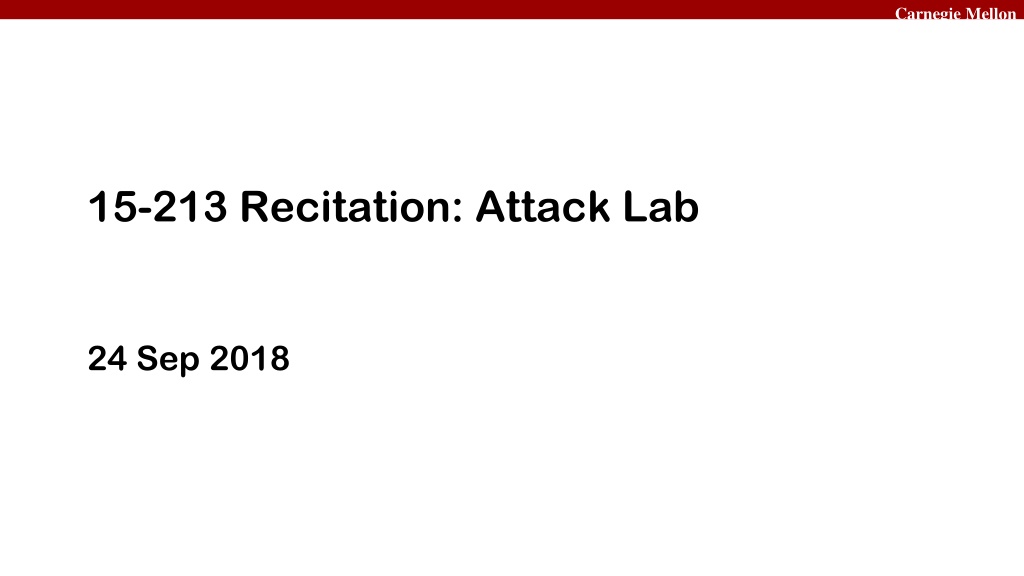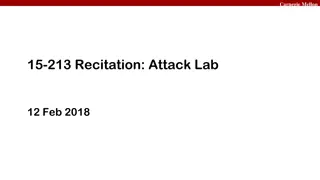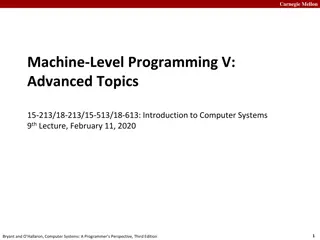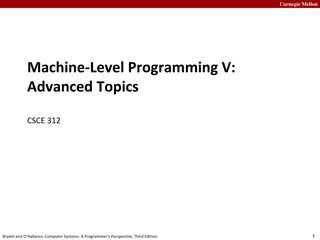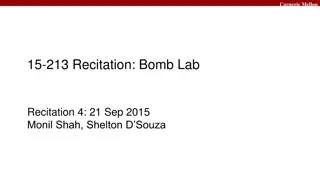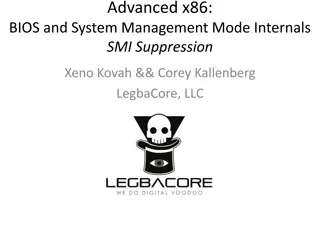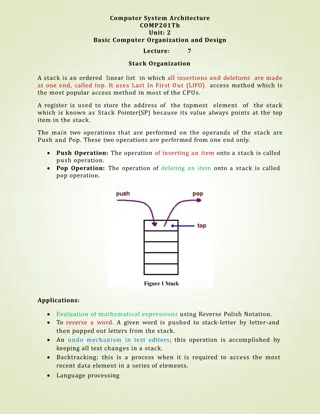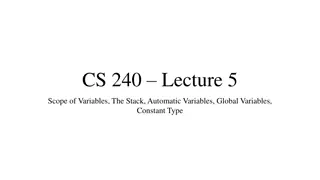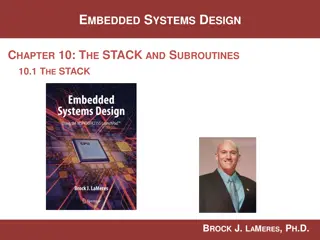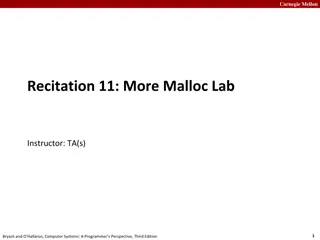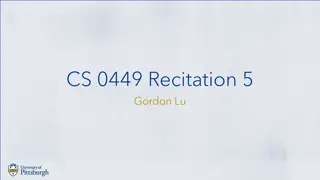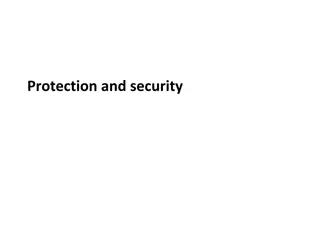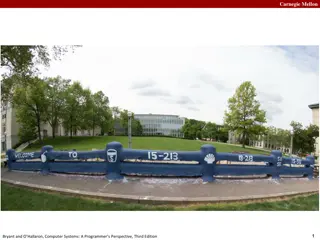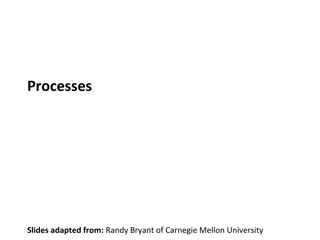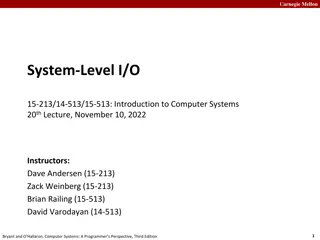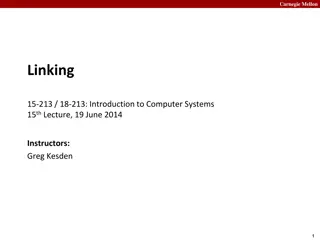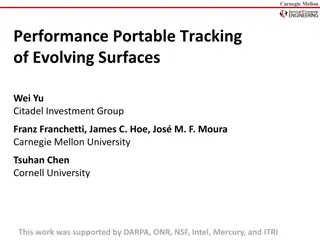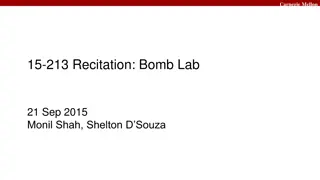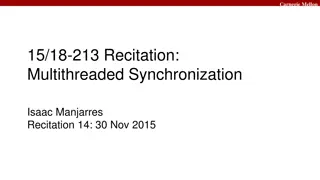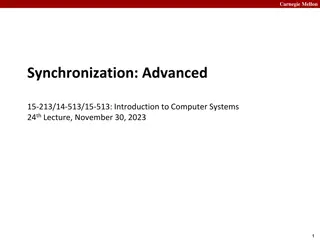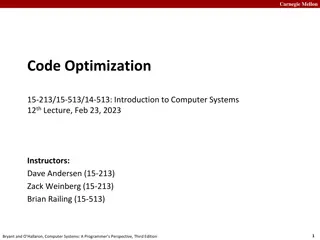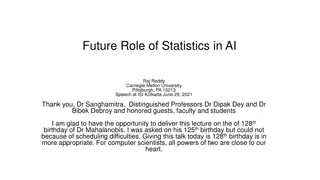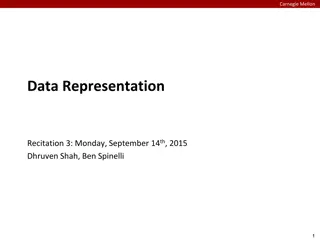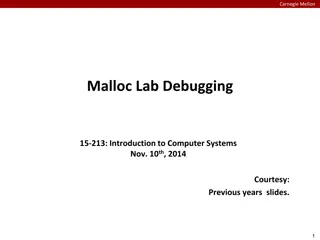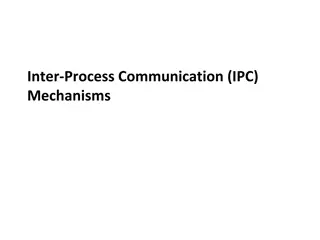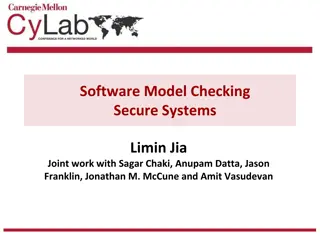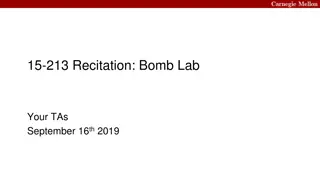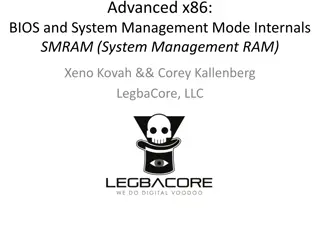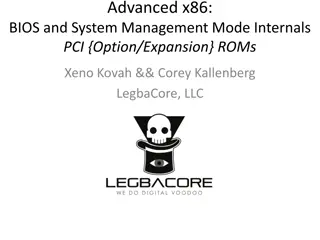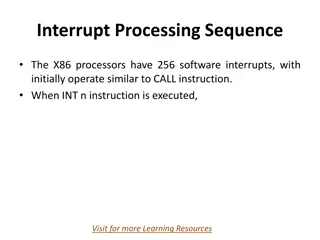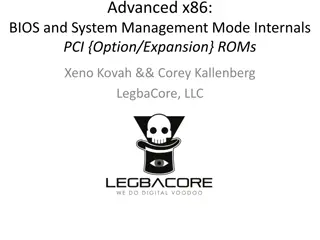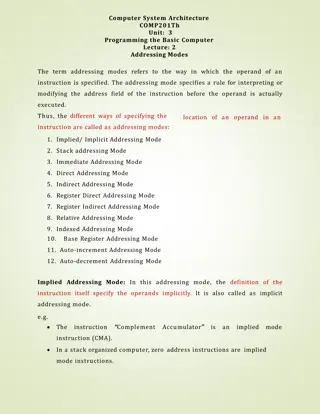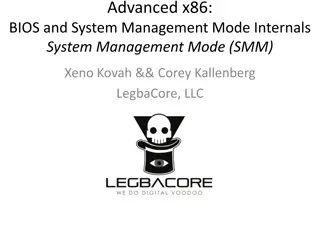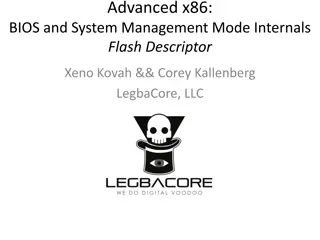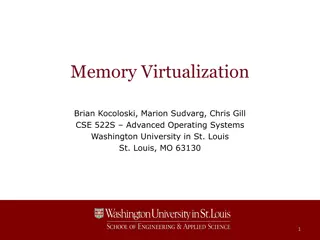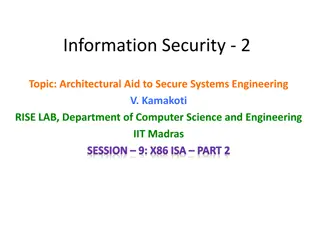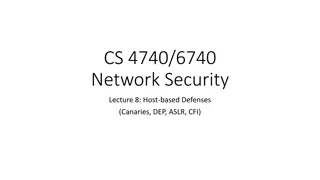Understanding x86-64 Stack and Register Usage at Carnegie Mellon
Explore the concepts of stack management, function invocation, and register usage in x86-64 architecture as taught in Carnegie Mellon's 15-213 recitation on Attack Lab. Learn about stack operations, caller vs. callee functions, and the conventions for using registers effectively. Gain insights into the crucial aspects of managing memory and handling function calls in low-level programming.
Download Presentation

Please find below an Image/Link to download the presentation.
The content on the website is provided AS IS for your information and personal use only. It may not be sold, licensed, or shared on other websites without obtaining consent from the author. Download presentation by click this link. If you encounter any issues during the download, it is possible that the publisher has removed the file from their server.
E N D
Presentation Transcript
Carnegie Mellon 15-213 Recitation: Attack Lab 24 Sep 2018
Carnegie Mellon Agenda Reminders Stacks Attack Lab Activities
Carnegie Mellon Reminders Bomb lab is due tomorrow (25 Sept, 2018) ! But if you wait until the last minute, it only takes a minute! NOT! Don t waste your grace days on this assignment! Attack lab will be released tomorrow!
Carnegie Mellon Stacks Last-in, first-out x86 stack grows down lowest address is top $rsp contains the address of the topmost element in the stack Uses the pushq and popq instructions to push and pop registers/constants onto and off the stack
Carnegie Mellon Stack bottom Stack pushq & popq pushq {value} is equivalent to sub $8, %rsp mov {value}, (%rsp) popq {reg} is equivalent to mov (%rsp), {reg} add $8, %rsp Stack top
Carnegie Mellon Stack Caller vs. Callee Function A calls function B A is the caller B is the callee Stack space is allocated in frames Represents the state of a single function invocation Frame used primarily for two things: Storing callee saved registers Storing the return address of a function
Carnegie Mellon Registers Caller-saved vs. Callee-saved Callee-saved If the function wants to change the register, it must save the original value in its stack frame and restore it before returning Caller-saved Registers used for function arguments are always caller- saved $rax is also caller-saved The calling function may store temporary values in callee-saved registers Called function may do as it wishes with the registers Must save/restore register in caller s stack frame if it still needs the value after a function call
Carnegie Mellon x86-64 Register Usage Conventions
Carnegie Mellon Registers Caller-saved vs. Callee-saved Before function call rdi = first argument rsi = second argument rax = some temporary value After function call rdi = garbage rsi = garbage rax = return value rbx = some important number to use later (15213) rsp = pointer to some important buffer (0x7fffffffaaaa) rbx = some important number to use later (15213) rsp = pointer to some important buffer (0x7fffffffaaaa)
Carnegie Mellon Stack bottom x86-64/Linux Stack Frame Current Stack Frame ( Top to Bottom) Argument build: - Parameters for function about to call Local variables - If can t keep in registers Saved register context Old frame pointer (optional) Caller Stack Frame Return address - Pushed by call instruction Arguments for this call Stack top
Carnegie Mellon Stack Maintenance Functions free their frame before returning Return instruction looks for the return address at the top of the stack What if the return address has been changed?
Carnegie Mellon Attack Lab We re letting you hijack programs by running buffer overflow attacks on them. Is that not justification enough? To understand stack discipline and stack frames To defeat relatively secure programs with return oriented programming
Carnegie Mellon Attack Lab Activities Three activities Each relies on a specially crafted assembly sequence to purposefully overwrite the stack Activity 1 Overwrites the return addresses Activity 2 Writes an assembly sequence onto the stack Activity 3 Uses byte sequences in libc as the instructions
Carnegie Mellon Attack Lab Activities One student needs a laptop Login to a shark machine $ wget http://www.cs.cmu.edu/~213/activities/rec5.tar $ tar xf rec5.tar $ cd rec5 $ make $ gdb act1
Carnegie Mellon Activity 1 (gdb) break clobber (gdb) run (gdb) x $rsp (gdb) backtrace Q. Does the value at the top of the stack match any frame?
Carnegie Mellon Activity 1 Continued (gdb) x /2gx $rdi (gdb) stepi // Here are the two key values // Keep doing this until (gdb) clobber () at support.s:16 16 ret (gdb) x $rsp Q. Has the return address changed? (gdb) finish // Should exit and print out Hi!
Carnegie Mellon Activity 1 Post Clobber overwrites part of the stack with memory at $rdi, including the all-important return address In act1 it writes two new return addresses: 0x400500: address of printHi() 0x400560: address in main Call clobber() Clobber executes In printHi() In main() ret 0x000000400560 ret 0x7fffffffe338 0x000000400560 0x000000400553 0x000000400500
Carnegie Mellon Activity 2 $gdb act2 (gdb) break clobber (gdb) run (gdb) x $rsp Q. What is the address of the stack and the return address? (gdb) x /4gx $rdi Q. What will the new return address be? (i.e., what is the first value?)
Carnegie Mellon Activitity 2 Continued (gdb) x/5i $rdi + 8 // Display as instructions Q. Why rdi + 8? Q. What are the three addresses? (gdb) break puts (gdb) break exit Q. Do these addresses look familiar?
Carnegie Mellon Activity 2 Post Normally programs cannot execute instructions on the stack Main used mprotect to disable the memory protection for this activity Clobber wrote an address that s on the stack as a return address Followed by a sequence of instructions Three addresses show up in the exploit: 0x48644d Hi\n string 0x4022e0 puts() function 0x4011a0 exit() function
Carnegie Mellon Activity 3 $gdb act3 (gdb) break clobber (gdb) run (gdb) x /5gx $rdi Q. Which value will be first on the stack? Q. At the end of clobber, where will the function return to?
Carnegie Mellon Activity 3 Continued (gdb) x /2i <return address> Q. What does this sequence do? Q. Do the same for the other addresses. Note that some are return addresses and some are for data. When you continue, what will the code now do?
Carnegie Mellon Activity 3 Post It s harder to stop programs from running existing pieces of code in the executable. Clobber wrote multiple return addresses (aka gadgets) that each performed a small task, along with data that will get popped off the stack while running the gadgets. 0x457d0c: pop %rdi; retq 0x47fa64: Pointer to the string Hi\n 0x429a6a: pop %rax; retq 0x400500: Address of a printing function 0x47f001: callq *%rax
Carnegie Mellon Activity 3 Post Note that some of the return addresses actually cut off bytes from existing instructions 0x457d0b 0c 0d ----------------------------------------- pop %r15 41 5f retq c3 pop %rdi retq c3 5f
Carnegie Mellon Attack Lab Tools gcc gcc c c test.s test.s; ; objdump Compiles the assembly code in test.s and shows the actual bytes for the instructions objdump d d test.o test.o > test.asm > test.asm ./hex2raw < exploit.txt > converted.txt ./hex2raw < exploit.txt > converted.txt Convert hex codes in exploit.txt into raw ASCII strings to pass to targets See the writeup for more details on how to use this ( (gdb gdb) ) display /12gx $ display /12gx $rsp Displays 12 elements on the stack and the next 2 instructions to run rsp ( (gdb gdb) ) display /2i $rip display /2i $rip GDB is also useful to for tracing to see if an exploit is working
Carnegie Mellon If you get stuck Please read the writeup. Please read the writeup. Please read the writeup. Please read the writeup! CS:APP Chapter 3 View lecture notes and course FAQ at http://www.cs.cmu.edu/~213 Office hours Sunday through Thursday 5:00-9:00pm in WH 5207 Post a private question on Piazza man gdb, gdb's help command
